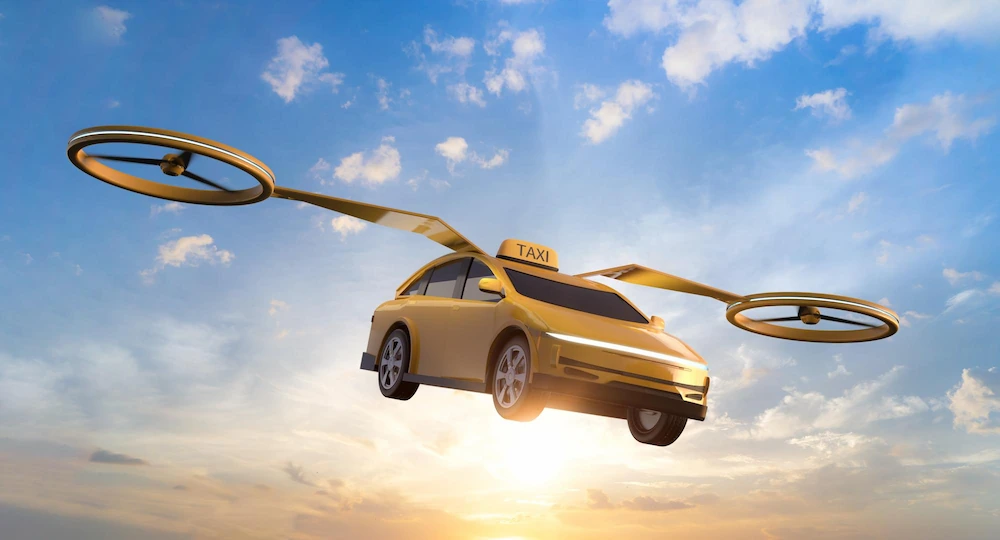


Imagine stepping into a taxi that doesn’t drive but instead flies in the air above the traffic. That sounds exactly like a flying taxi, right? A very futuristic concept indeed, except for the fact that it’s no longer a concept, it’s becoming real. With urban air mobility (UAR) on the rise, flying vehicles may no longer be fiction, but a reality.
In this blog, we’ll explore how flying taxis are revolutionising urban transport and whether they’re ready to take-off in the next decade.
What is Urban Air Mobility (UAM)?
Urban Air Mobility (UAR) is a new air transportation system made possible because of small, electric vertical take-off and landing (eVTOL) aircraft for air-based transport in urban areas. These aircraft are equipped with new technologies such as enhanced battery technologies and electric propulsion. This allows for faster, more efficient travel in cities.
Why Are Flying Taxis Trending?
Flying taxis have been getting a lot of attention recently for many reasons. Here is why it’s possible that these could be the future of urban transportation:
Challenges to Flying Taxis
Regardless of the excitement around urban air mobility (UAM), there are several other factors that may cause a hurdle and need to addressed;
What’s Holding Back the Take-off of Flying Taxis?
While the concept of flying cars still seems very fictional, we can expect to see significant progress in this aspect of taxis in the near future, most probably within the next decade.
By 2025, flying taxis will likely undergo several tests and small-scale operations in selected cities. By 2030, these taxis are most likely to begin serving regular routes in the urban areas, along with possible integration into public transport systems. In the coming years after 2030, flying taxis might become a common sight, with dedicated landing zones and systems in place to manage air traffic, making them a part of everyday transportation.
Final Thoughts
Flying taxis are still in the early stages of development, but because of the potential they hold, they are most probably going to bring a drastic change to urban transportation in the future. Due to the heavy integration of technology and infrastructure in almost everything in this era, it won’t be surprising to see flying taxis as a part of our daily commute in the next decade or so.
Frequently Asked Questions About Urban Air Mobility (UAM) and Flying Taxis
Urban Air Mobility (UAM) refers to the use of small, electric vertical take-off and landing (eVTOL) aircraft to provide air-based transportation in urban areas. These flying taxis aim to bypass road congestion and offer a faster, more efficient way to travel in cities.
The price of flying taxis is still being determined, as the technology is still in development. Initially, flying taxis are expected to be expensive due to the new technology involved, but prices are expected to become more affordable over time as the technology becomes more mainstream. Early adopters and business clients may pay higher fares, while public services could offer more reasonable pricing as demand increases.
The market for Urban Air Mobility (UAM) is rapidly growing, with estimates suggesting that the global UAM market could be worth billions of dollars in the next few decades. The growing demand for faster urban transport, combined with technological advancements in electric propulsion and autonomous flight, is driving this market's expansion.
Urban Air Mobility is constantly evolving. Some of the latest developments include successful prototype flights by companies like Joby Aviation, Lilium, and Volo-copter. Major companies such as Airbus and Boeing are also investing heavily in flying taxi technologies. Keep up with the latest news by following updates from aviation tech companies and government regulations regarding eVTOL aircraft.
While drones are typically used for small payloads and delivery services, the concept of drones in UAM is being explored. Drones could evolve into larger, autonomous flying taxis capable of carrying passengers, and companies are experimenting with both passenger drones and eVTOL aircraft to meet the needs of urban transport.
Advanced Air Mobility (AAM) includes both Urban Air Mobility (UAM) and Advanced Air Logistics, such as delivery drones. The benefits include reduced traffic congestion, faster commutes, sustainability (via electric propulsion), and improved air quality in cities. AAM also promises on-demand mobility, helping meet transportation needs in crowded urban areas.
Yes, Airbus is one of the key players in the Urban Air Mobility (UAM) market. The company is developing Vahana, a self-piloted aircraft designed for urban transportation. Airbus is actively involved in researching and testing the use of flying taxis as part of the UAM ecosystem, in collaboration with other aviation companies and governments.
As Urban Air Mobility continues to grow, several companies involved in UAM technologies are beginning to see their stock prices rise. Investors are closely watching the development of flying taxi companies, battery technology providers, and aircraft manufacturers. If the technology becomes widespread, it could significantly impact the stock market, offering potential investment opportunities in this new industry.